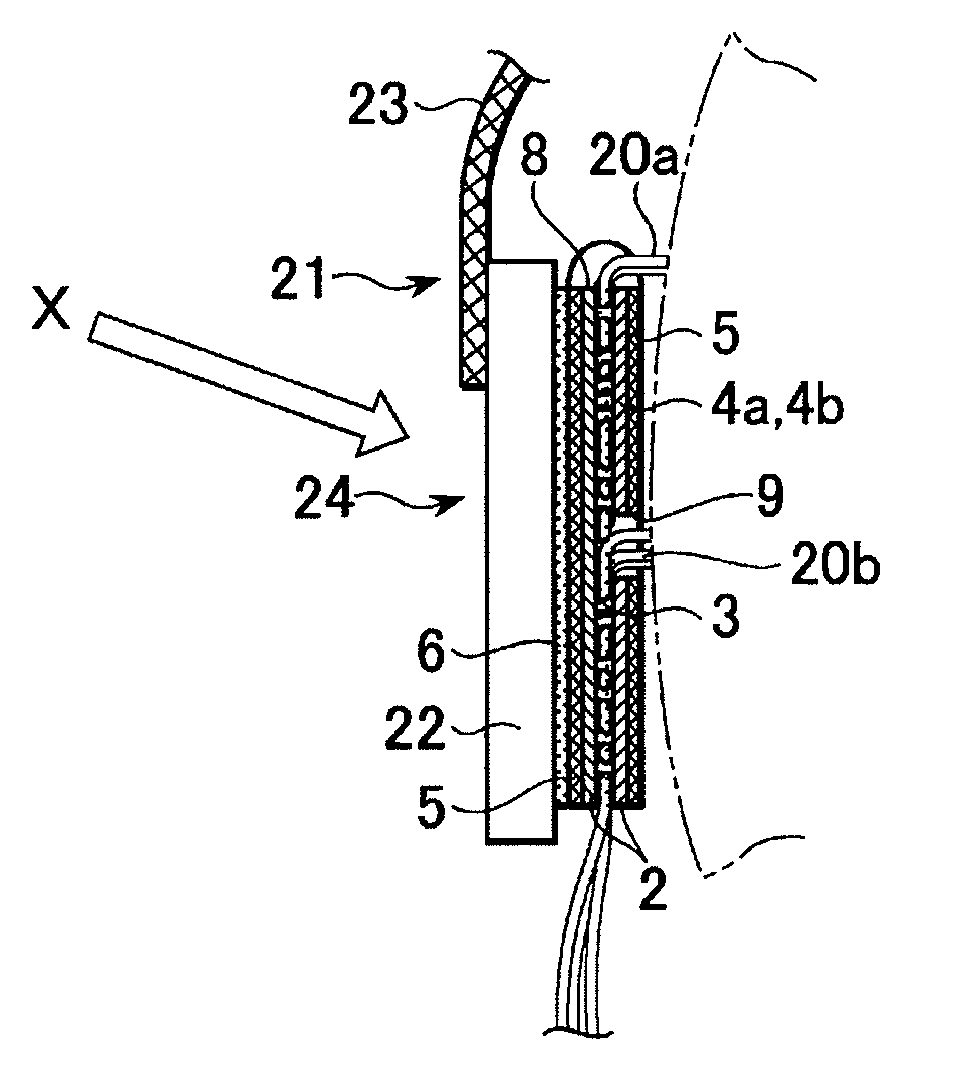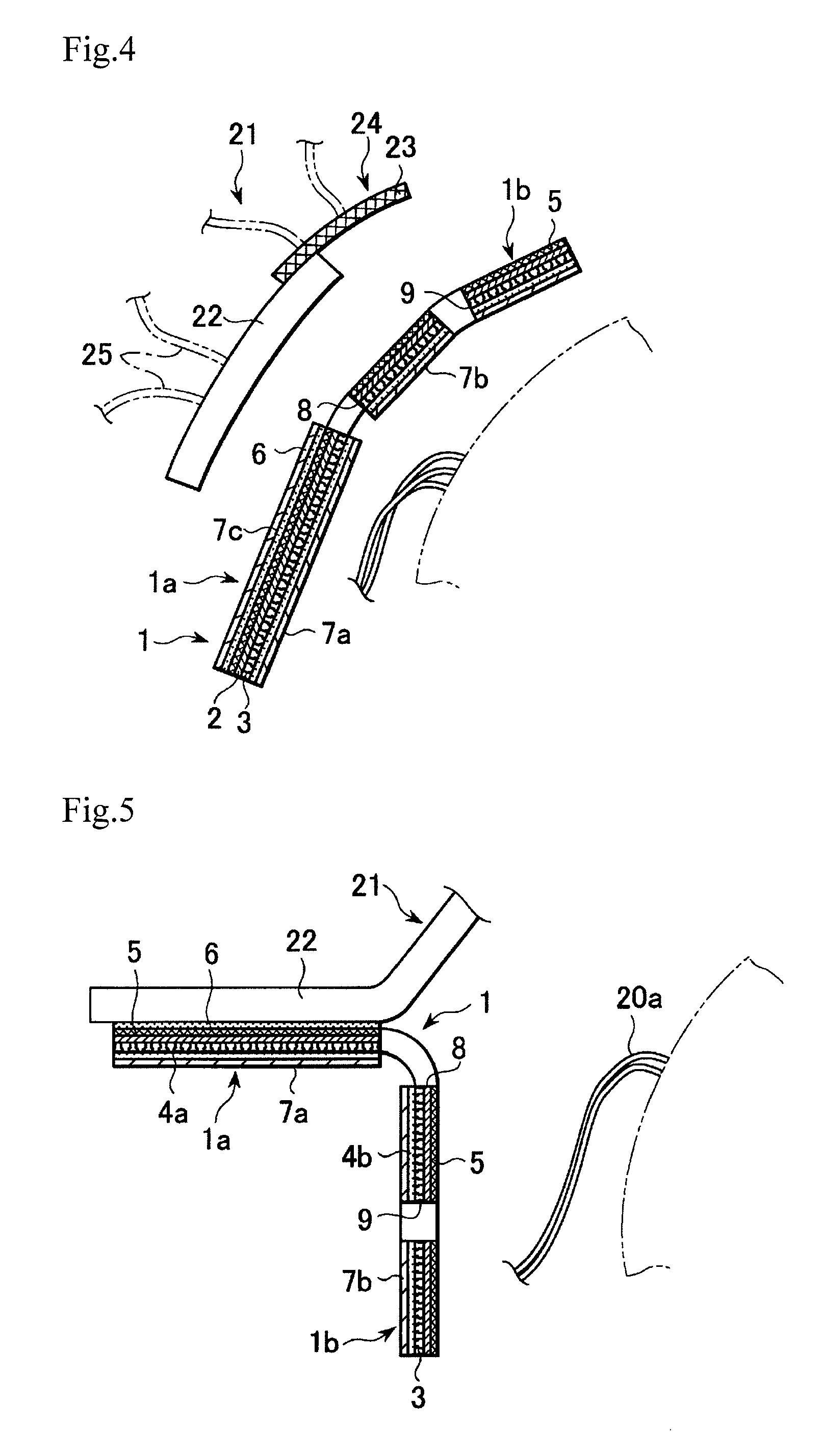Apparatus for fixing a wig and method for fixing a wig using the apparatus
a technology for fixing wigs and wigs, applied in the direction of applications, weaving, snap fasteners, etc., can solve the problems of user pain, wear or take off, wigs tend to slip out of place, etc., and achieve the effect of keeping the tangling state, increasing the states, and keeping the good wig wearing sta
- Summary
- Abstract
- Description
- Claims
- Application Information
AI Technical Summary
Benefits of technology
Problems solved by technology
Method used
Image
Examples
example 1
[0068]The following conditions are set for the apparatus 1 employed in Example 1.[0069]Size of the flexible plane sheet 2: 25 mm in the length E, 20 mm in the width F, and 9 mm in the length G to the first opening 8 on the first half area 1a side[0070]Thickness of the flexible plane sheet 2: 0.15 mm[0071]Size of each monofilament 3: 0.25 mm in the diameter d1 of the stalk 3a, 0.40 mm in the height h1 of the stalk 3a, 0.40 mm in the diameter d2 of the head 3b, and 0.30 mm in the diameter d3 of the head 3b [0072]Interval between the heads 3b of the monofilaments 3: 0.30 mm in the interval c1 between the heads 3b and 0.15 mm in the interval c2 between the heads 3b [0073]Interval between the stalks 3a of the monofilaments 3: 0.40 mm in the interval c3 between the stalks 3a and 0.20 mm in the interval c4 between the stalks 3a [0074]Thickness of the first adhesive layers 4a, 4b: 0.10 mm.[0075]Adhesive force of the first adhesive layers 4a, 4b: 2.23 kg / cm.[0076]Thread diameter of the net m...
example 2
[0083]The apparatus 1 employed in Example 2 is the same as that in Example 1 except that the following conditions were set smaller than those in Example 1.[0084]Size of the flexible plane sheet 2: 20 mm in the length E[0085]Thickness of the flexible plane sheet 2: 0.11 mm[0086]Size of each monofilament 3: 0.20 mm in the diameter d1 of the stalk 3a, 0.21 mm in the height h1 of the stalk 3a, 0.22 mm in the diameter d2 of the head 3b, and 0.20 mm in the diameter d3 of the head 3b [0087]Interval between the heads of the monofilaments 3: 0.11 mm in the interval c1 between the heads 3b and 0.10 mm in the interval c2 between the heads 3b [0088]Interval between the stalks of the monofilaments 3: 0.22 mm in the interval c3 between the stalks 3a [0089]Thickness of the first adhesive layers 4a, 4b: 0.05 mm[0090]Adhesive force of the first adhesive layers 4a, 4b: 1.53 Kg / cm[0091]Thread diameter of the net member 5: 0.03 mm[0092]Number of meshes of the net member 5: 100 meshes / inch
example 3
[0093]The apparatus 1 employed in Example 3 is the same as that in Example 1 except that the following conditions were set larger than those in Example 1. It should be noted that only the height 1 of the stalk 3a is set smaller that that in Example 1 in view of the other conditions.[0094]Size of the flexible plane sheet 2: 30 mm in the length E and 28 mm in the width F[0095]Thickness of the flexible plane sheet 2: 0.20 mm[0096]Size of each monofilament 3: 0.40 mm in the diameter d1 of the stalk 3a, 0.38 mm in the height h1 of the stalk 3a, and 0.40 mm in the diameter d3 of the head 3b [0097]Interval between the heads 3b of the monofilaments 3: 0.30 mm in the interval c2 between the heads 3b [0098]Interval between the stalks of the monofilaments 3: 0.40 mm in the interval c4 between the stalks 3a [0099]Thickness of the first adhesive layers 4a, 4b: 0.20 mm[0100]Adhesive force of the first adhesive layers 4a, 4b: 3.00 kg / cm[0101]Thread diameter of the net member 5: 0.08 mm[0102]Number...
PUM
| Property | Measurement | Unit |
|---|---|---|
| height | aaaaa | aaaaa |
| size | aaaaa | aaaaa |
| size | aaaaa | aaaaa |
Abstract
Description
Claims
Application Information
 Login to View More
Login to View More - R&D
- Intellectual Property
- Life Sciences
- Materials
- Tech Scout
- Unparalleled Data Quality
- Higher Quality Content
- 60% Fewer Hallucinations
Browse by: Latest US Patents, China's latest patents, Technical Efficacy Thesaurus, Application Domain, Technology Topic, Popular Technical Reports.
© 2025 PatSnap. All rights reserved.Legal|Privacy policy|Modern Slavery Act Transparency Statement|Sitemap|About US| Contact US: help@patsnap.com



